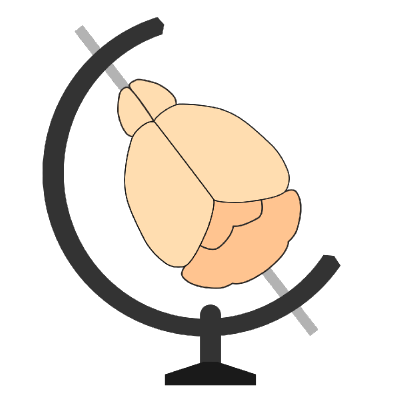Actors#
Everything rendered in brainrender is first used to create an instance of brainrender’s Actor class. This
class handles the 3D mesh data for the object to be rendered and provides a few useful methods for the
behind-the-scenes work necessary to render your data.
Caution
Before rendering data in brainrender you should ensure that they are registered to a reference atlas. Check how to use your data in brainrender.
While a general Actor class can be used to render any type of data that can be used to create a
vedo Mesh object, several specific Actor classes are provided for more conveniently
loading commonly used data types.
Specific actor classes#
brainrender.actors.Neuronis used to render neurons morphology (e.g. downloaded withmorphapior from a.swcfile).brainrender.actors.Pointsis used to render anything that can be represented as a set of points (e.g. labelled cells fromcellfinder.Pointscan load data directly from a.npyfile or a numpy array of coordinates can be passed to it.brainrender.actors.Streamlinesis used to render streamlines tractography data. It expects the data as apandasDataFrame and can load data from a.jsonfile.brainrender.actors.Lineis used to render a line. It expects a (N, 3) numpy array of coordinates.brainrender.actors.Volumerenders volumetric data (e.g. gene expression) from a numpy array or from a.npyfile.Other actor classes like
Cylinder,PointandRulercan be used to render other types of data.
In all cases an actor instance can be created by passing the data to be rendered to the dedicated Actor class.
For instance, to render the position of labelled cells, a Nx3 numpy array with the cells coordinates has to be passed
to the Points class to create an actor representing the cells’ locations. Some actors can also load data directly
from file.
Hint
Some types of actors (e.g. Streamlines and Neuron) are generally used to visualize several instances of the
same neuron at once. For these actors we also provide helper functions that facilitate the generation of multiple
instances of the same actor class.
Visualizing other types of data#
While the provided Actor classes should support the vast majority of users’ needs, occasionally you might need
to render an unsupported type of data. See here for details.
Adding actors to your scene#
Rendering actors is as simple as can be: just use the Scene.add method and pass to it the actors you would like
to see added to your rendering.
